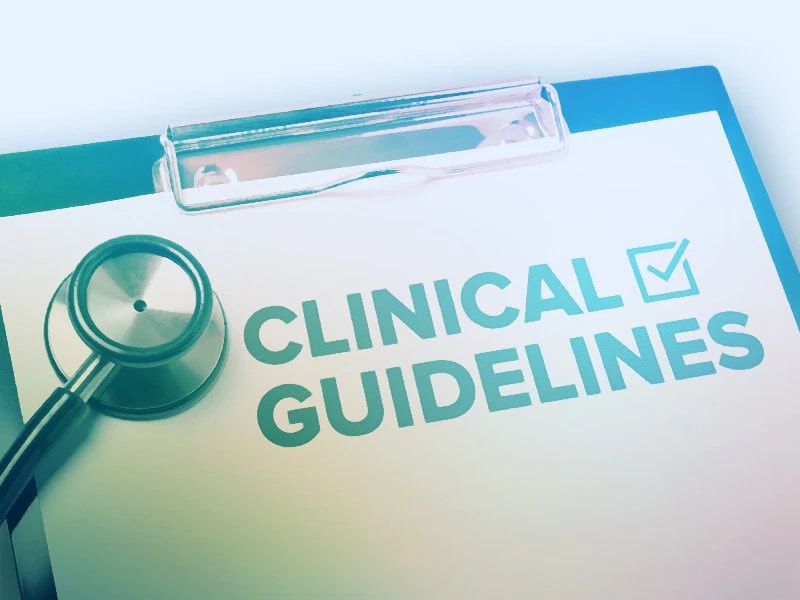Hyperbilirubinemia Clinical Practice Guidelines (AAP, 2022) - Medscape Reference

Updated guidelines on the management of hyperbilirubinemia in newborn infants of 35 or more weeks of gestation were published in August 2022 by the American Academy of Pediatrics (AAP) in Pediatrics.[1,2] Neonatal hyperbilirubinemia is common, and complications are rare; early identification of potential severe and devastating neurologic effects such as acute encephalopathy and kernicterus is crucial. Select strong or moderate recommendations are summarized below.
Prevention
Infants of mothers with unknown (due to no prenatal antibody screening) or positive maternal antibody screening should undergo direct antiglobulin testing (DAT) as well as blood typing via cord or peripheral blood.
Avoid oral supplementation with water or dextrose water for prevention of hyperbilirubinemia or for reducing bilirubin concentrations (strong recommendation).
Assessment and Monitoring
Total serum bilirubin (TSB) should be the definitive test for guiding phototherapy and escalating care, including exchange transfusion.
Visually assess all infants for jaundice a minimum of every 12 hours post delivery until discharge. Measure levels of TSB or transcutaneous bilirubin (TcB) as soon as possible for infants observed to be jaundiced less than 24 hours after birth (strong recommendation).
For identification of potential pathologic stasis, measure total and direct-reacting (or conjugated) levels of bilirubin in breastfed infants still jaundiced at age 3-4 weeks, as well as formula-fed infants still jaundiced at age 2 weeks.
Treatment
The AAP provides new TSB thresholds for intensive phototherapy on the basis of infants' gestational age, risk factors for hyperbilirubinemia neurotoxicity, and age in hours. (However, infants may be treated at lower levels, based on individual circumstances, family preferences, and shared decision-making with clinicians.)
In the setting of inpatient phototherapy, measure TSB within 12 hours of initiation. Guide the timing of the first postphototherapy TSB measurement and the frequency of TSB monitoring during phototherapy based on infants' age, the presence of risk factors for hyperbilirubinemia neurotoxicity, and TSB level and trajectory.
In the setting of home phototherapy, measure TSB daily. Admit the infant for inpatient phototherapy with elevations of TSB, narrowing of the difference between the TSB and phototherapy threshold, or when the TSB level is at least 1 mg/dL above the phototherapy threshold.
To evaluate for anemia or obtain a baseline in case anemia develops in infants requiring phototherapy, measure hemoglobin concentration, hematocrit, or complete blood count (CBC). For assessing the underlying cause(s) of hyperbilirubinemia in infants requiring phototherapy, obtain a DAT in infants of mothers with a positive antibody screen, a maternal O blood group regardless of Rh(D) status, or mothers who are Rh(D)-.
Measure glucose-6-phosphate dehydrogenase (G6PD) activity in any infant with jaundice of unknown cause in the setting of TSB elevations despite intensive phototherapy, sudden TSB increases or increases after an initial decline, or escalation of care.
Base repeat postphototherapy bilirubin measurement on the risk of rebound hyperbilirubinemia. Measuring TcB instead of TSB is an option if at least 24 hours have passed since the cessation of phototherapy.
Escalate care when an infant's TSB reaches or exceeds the escalation-of-care threshold (2 mg/dL below the exchange transfusion threshold) for infants without known risk factors for hyperbilirubinemia neurotoxicity, or for infants with rising TSB despite phototherapy or infants with at least one recognized risk factor for hyperbilirubinemia.
When escalation of care is required, obtain STAT levels of total and direct-reacting serum bilirubin, CBC, serum albumin and chemistries, as well as type and crossmatch.
Measure TSB at least every 2 hours from the initiation of escalation of care until the end of such escalation of care. When the TSB is below the threshold of escalation of care, follow the recommendations for monitoring infants on phototherapy.
Predischarge, provide all families with written and verbal education about neonatal jaundice. Provide written information for ease of postdischarge care (eg, date, time, place of followup appointment; a prescription and followup appointment for TcB or TSB, as needed). Provide the infant's primary care provider with the birth hospitalization information (eg, last TcB or TSB and the age at measurement, any DAT results). If it is unclear who will provide the infant's followup care, provide such information to the families. (Strong recommendation).
For more information, please go to Conjugated Hyperbilirubinemia, Unconjugated Hyperbilirubinemia, and Phototherapy for Jaundice.

Comments
Post a Comment